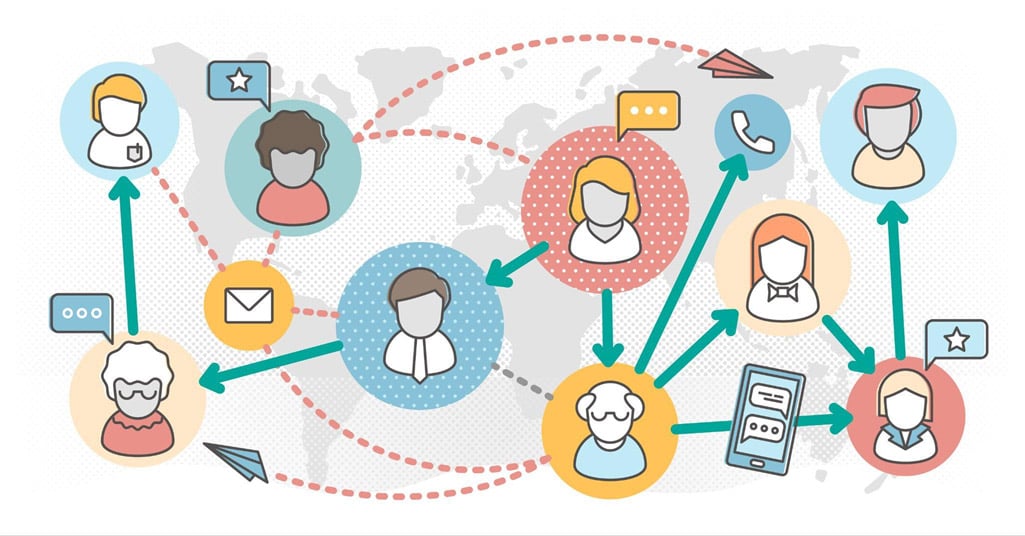Written by Sean McPheat | 

Influencer-driven sales are the new rockstars of the marketing world!
Picture this…
Your product is in the hands of influencers who know exactly how to make it shine.
That’s the magic of influencer-driven strategies!
In this blog, we’ll unpack how to use the power of social media stars to skyrocket your sales, with a few pro tips from a leading sales training company to help you optimise your sales approach in today’s competitive market.

According to Sprout Social, influencer marketing was worth over $20 billion worldwide in 2023. The Digital Marketing Institute found that Gen-Z consumers trust influencers significantly more than celebrities, with 45% more willing to buy an item recommended by an influencer they trust over celebrities, or even their peers.
Social media channels like Instagram, YouTube, and TikTok have become major marketing channels for brands to position their wares in front of millions of potential consumers, using influencers as the medium of persuasion.
Influencer marketing works because it leverages trust, authenticity, and relatability.
Unlike traditional advertising, which can feel impersonal or overly commercial, influencer partnerships offer a personal touch. Younger audiences, especially Millennials and Gen Z, gravitate towards influencers who feel like peers, making them more likely to trust product endorsements from influencers they follow.
Or to put it another way, influencers simply seem less phoney and less sales-y than legacy forms of advertising or marketing.
According to a study by Nielsen, as early as 2012 it was already the case that 92% of consumers trust recommendations from individuals, even if they don’t know them personally, over traditional ads.
The growing field of influencer marketing took that impressive truth and ran with it. People value a one-to-one human connection over the slick messaging of corporate marketing teams.
By the mid-2010s, influencer-driven sales were thriving. People felt drawn to influencers who shared their values, lifestyles, and interests.
Although influencer marketing has an authenticity and directness that other forms of marketing lack, it still requires significant strategic planning.
To maximise influencer-driven sales, brands need a carefully crafted social media strategy that aligns with their business goals.
The core of any successful strategy revolves around understanding your target audience, identifying the right influencers, and creating authentic relationships.
It is best to begin by defining the essential characteristics of your target audience; you can then map this onto existing audiences and influencers to identify a close match. In traditional marketing terms, this means describing your typical buyer persona.
You also need to identify the essential aspects of your brand, to make sure you achieve a close alignment between your brand values and the influencer’s.
Let’s turn to the practical side of achieving these brand-influencer partnerships.

Before you can identify your perfect influencer partner, you must develop a strategy to use such influence to promote your brand. This strategy should include:
Setting specific objectives—such as increasing brand awareness, driving influencer-driven sales, or boosting engagement—is essential for measuring the success of your campaign.
Not all influencers will align with your brand. Look for influencers who share your values, resonate with your target audience, and have a strong social media presence.
Allow influencers to create content in their style, maintaining authenticity while promoting your product. This builds trust with their audience and increases the effectiveness of product endorsements.
Use metrics like engagement rates, click-through rates, and influencer-generated sales to determine the effectiveness of a campaign. Analytics tools like Google Analytics or influencer marketing platforms can track performance.
Item two in that list is perhaps the most crucial step.
Let’s investigate it a little more deeply.
As we’ve seen, creating effective influencer partnerships includes aligning brand values with influencers’ content.
Influencers should genuinely connect with your product, making endorsements feel natural. Begin by researching influencers who speak to your target demographic and whose personal brand aligns with your business.
For example:
Look at the types of individuals who follow the influencers you think will suit your brand. There may even be AI research tools to help you find a suitable match by analysing influencer followers at scale.
Finding a good match means you don’t have to try to force an influencer to adopt an approach, or like a product, they would not normally be drawn to. The individual you partner with will naturally like and want to celebrate your brand. By achieving this ideal match, you dodge the dreaded risk of phoniness.
By engaging influencers early in the product development cycle, offering creative freedom, and nurturing long-term partnerships you can achieve more authentic and successful product promotion.

Influencer engagement is about building genuine connections. Offering exclusive discount codes, giveaways, or product sneak peeks creates a sense of exclusivity, driving social media outreach and influencing potential buyers.
Let’s turn to some effective techniques known to maximised influencer-driven product sales:
This is not an exhaustive list of approaches but gives you a flavour of some tried and tested methods for achieving sales using social media influencers.
Partner with influencers to introduce new products through exclusive campaigns. This creates buzz and taps into the influencer’s established audience, helping boost sales growth.
Invite influencers to co-create content around your product. Videos, tutorials, and product reviews shared across both the influencer’s and brand’s platforms can expand reach and drive product sales.
Running giveaways or contests with influencers can significantly increase engagement and brand visibility. Encourage followers to like, share, or tag others to enter, increasing reach. By offering one of your products as a prize, you also create excitement around your brand, driving more people to check out your product.
Set up an affiliate program where influencers earn commissions for each sale they drive. This incentivizes influencers to actively promote your product and gives you a measurable way to track the success of influencer-driven sales. Affiliate links or codes are straightforward ways to track these conversions.
While big influencers have large followings, micro-influencers (those with 1,000–100,000 followers) often have highly engaged and niche audiences. By partnering with multiple micro-influencers, brands can create a more personal connection with their audience, driving targeted product sales.
Create a sense of urgency by offering exclusive discounts or promotions that are only valid for a brief period and exclusive to an influencer’s audience. This not only boosts engagement but also encourages immediate action, leading to higher conversion rates and social media outreach.
Influencers who specialise in educational content can show how your product fits into their everyday lives through tutorials or how-to videos. This method highlights the practical benefits of your product, encouraging their followers to envision themselves using it, which can lead to increased product sales.
Organising a live stream with an influencer where they demo your product or answer questions in real-time can be a powerful engagement tool. This format allows potential customers to interact directly with the influencer, ask questions, and gain immediate insights into the product, helping build trust and credibility.
Encourage influencers to invite their followers to create content using your product. User-generated content adds another layer of social proof, demonstrating real-world use cases and testimonials from other consumers. This approach increases trust and can lead to greater sales growth.
Allow influencers to take over your brand’s social media account for a day or during a specific event. This creates excitement, offers a fresh perspective, and gives followers of the influencer more reason to engage with your brand directly. It’s a dynamic way to blend influencer marketing with your broader social media strategy.
By employing these diverse influencer-driven sales tactics, brands can create multiple touchpoints to reach their target audience, build credibility, and ultimately boost product sales.
The great news about influencer-driven strategy overall is that you have the freedom to be truly creative and collaborative in your approach to marketing and sales.
Social media promotion through influencer campaigns amplifies product endorsements. The best campaigns will generate content that can be repurposed across several different social media platforms.
For instance, you might create a YouTube video and TikTok post with the same video content, then generate a Facebook reel and grab a couple of screenshots for Instagram, all from the same initial piece of content.
Don’t spread your creativity too thinly, however. Focus on platforms where your target audience spends the most time and collaborate with influencers who already have a strong presence there.
Make sure each post is optimised for the medium, using the trending hashtags and SEO keywords.
Sponsored posts, stories, and even influencer takeovers are great ways to generate buzz and increase product visibility.

Digital marketing efforts such as email marketing, retargeting ads, and SEO can enhance the impact of influencer campaigns by providing additional opportunities to engage potential customers.
While influencers help raise awareness and introduce your product to new audiences, digital marketing ensures those who have shown interest continue to be engaged through multiple touchpoints.
Email marketing campaigns can target leads captured through influencer promotions, offering exclusive deals or additional information about the product.
Retargeting ads, on platforms like Facebook or Google, can remind visitors who viewed influencer content but did not purchase, encouraging them to return and complete the purchase.
SEO strategies also play a role by optimising web content and influencer landing pages, driving more organic traffic to your site.
When digital marketing is combined with influencer campaigns, it reinforces brand messaging and product visibility, leading to more conversions and maximise sales.
When combined with digital marketing tactics, influencer marketing becomes a comprehensive sales strategy for engaging potential customers at multiple stages of their buyer’s journey.
Social media outreach, driven by influencer campaigns, can generate significant awareness and drive traffic to your website. To ensure this traffic converts into sales, follow up with targeted digital marketing efforts such as personalised email marketing, lead nurturing campaigns, and paid social ads.
For example, after an influencer posts about your product, you can run retargeting ads to visitors who clicked the post but didn’t make a purchase. Similarly, personalised offers sent via email to followers who engage with the influencer can increase conversion rates.
This integration of social media outreach and digital marketing not only enhances the visibility and effectiveness of influencer campaigns but also ensures long-term engagement, leading to higher conversion rates and more consistent sales growth.
Social selling and influencer marketing are natural allies in modern digital strategies, working together to build stronger customer relationships and drive sales.
While influencers are great at generating initial interest and buzz around a product, social selling enables brands to nurture that interest into a sale.
Social selling involves using social media platforms to directly engage with potential customers, answer their questions, provide recommendations, and guide them through the purchasing process.
This works particularly well when influencers introduce a product to their followers, creating a foundation of trust. Brands can then follow up by interacting with the same audience on social media, offering more personalised responses and deals, or further information that helps them make a buying decision.
Together, influencer marketing generates awareness and demand, while social selling helps convert that interest into measurable sales, providing a full-circle customer experience.

Tracking the success of influencer campaigns is key to understanding your return on investment (ROI).
To assess whether an influencer campaign is driving product sales, brands must utilise a variety of tracking tools. Affiliate links and unique discount codes assigned to each influencer can give you direct insight into the sales generated from a particular influencer.
UTM codes added to links in an influencer’s post allow you to monitor traffic and conversions in Google Analytics, providing a detailed view of how users interact with your product after seeing influencer content.
Social media platforms also offer analytics tools, such as Instagram Insights or YouTube Analytics, which provide data on reach, impressions, and engagement.
Regularly reviewing these campaign metrics enables brands to optimise their influencer marketing strategies and make data-driven decisions to improve future efforts.
Engagement rate (likes, comments, shares) is a crucial metric for determining how well an influencer’s content resonates with their audience. Higher engagement typically means that followers are actively interacting with the content, which increases the likelihood of sales conversions.
CTR measures how many users clicked on the influencer’s link to your product or website. A higher CTR indicates that the influencer successfully piqued interest and prompted their audience to take the next step in the buying journey.
Conversion rate tracks how many users who clicked on the influencer’s link or engaged with their content made a purchase. This is one of the most direct indicators of whether the influencer campaign is working.
This metric measures the total sales generated from an influencer campaign, either through affiliate links, unique discount codes, or other tracking methods. It demonstrates how much revenue the campaign has directly contributed.
ROI is essential for determining the overall profitability of an influencer campaign. By comparing the cost of the campaign to the revenue generated, brands can assess whether their investment in influencer partnerships is worthwhile.
A successful influencer campaign often results in an increase in followers or subscribers for your brand. Beyond mere sales, monitoring your audience growth after a campaign can indicate how well the influencer drove awareness and interest in your brand.
Together, these metrics provide an overview of the impact and effectiveness of influencer marketing campaigns. Monitoring them allows brands to refine their strategies and maximise future returns.
Influencer marketing, when integrated with a solid digital marketing plan, can have a transformative impact on product sales.
By crafting a strategic approach around influencer partnerships, brands can tap into the power of social media to generate product endorsements, drive engagement, boost social selling, and generate revenue.
Ready to take your sales to the next level?
Check out some of our courses like our Selling Skills Training and Sales Management Training.
Alternatively check out our Sales Assessment and Sales Personality Testing to optimise your strategy and maximise results!

Sean McPheat
Managing Director
MTD Sales Training
Updated on: 17 October, 2024
Related Articles

Search For More
